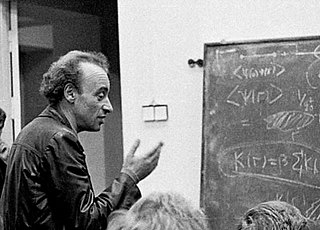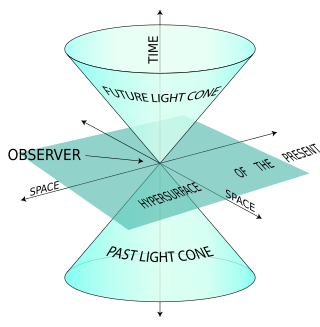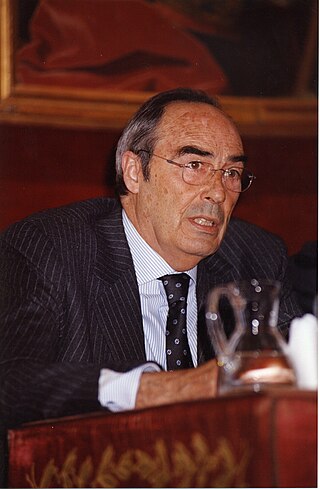Related Research Articles

In theoretical physics, quantum chromodynamics (QCD) is the theory of the strong interaction between quarks mediated by gluons. Quarks are fundamental particles that make up composite hadrons such as the proton, neutron and pion. QCD is a type of quantum field theory called a non-abelian gauge theory, with symmetry group SU(3). The QCD analog of electric charge is a property called color. Gluons are the force carriers of the theory, just as photons are for the electromagnetic force in quantum electrodynamics. The theory is an important part of the Standard Model of particle physics. A large body of experimental evidence for QCD has been gathered over the years.

In physics, a coupling constant or gauge coupling parameter, is a number that determines the strength of the force exerted in an interaction. Originally, the coupling constant related the force acting between two static bodies to the "charges" of the bodies divided by the distance squared, , between the bodies; thus: in for Newtonian gravity and in for electrostatic. This description remains valid in modern physics for linear theories with static bodies and massless force carriers.

Lattice QCD is a well-established non-perturbative approach to solving the quantum chromodynamics (QCD) theory of quarks and gluons. It is a lattice gauge theory formulated on a grid or lattice of points in space and time. When the size of the lattice is taken infinitely large and its sites infinitesimally close to each other, the continuum QCD is recovered.

Two-photon physics, also called gamma–gamma physics, is a branch of particle physics that describes the interactions between two photons. Normally, beams of light pass through each other unperturbed. Inside an optical material, and if the intensity of the beams is high enough, the beams may affect each other through a variety of non-linear effects. In pure vacuum, some weak scattering of light by light exists as well. Also, above some threshold of this center-of-mass energy of the system of the two photons, matter can be created.

In particle physics, the history of quantum field theory starts with its creation by Paul Dirac, when he attempted to quantize the electromagnetic field in the late 1920s. Heisenberg was awarded the 1932 Nobel Prize in Physics "for the creation of quantum mechanics". Major advances in the theory were made in the 1940s and 1950s, leading to the introduction of renormalized quantum electrodynamics (QED). QED was so successful and accurately predictive that efforts were made to apply the same basic concepts for the other forces of nature. By the late 1970s, these efforts successfully utilized gauge theory in the strong nuclear force and weak nuclear force, producing the modern Standard Model of particle physics.
In particle physics, the parton model is a model of hadrons, such as protons and neutrons, proposed by Richard Feynman. It is useful for interpreting the cascades of radiation produced from quantum chromodynamics (QCD) processes and interactions in high-energy particle collisions.
The J. J. Sakurai Prize for Theoretical Particle Physics, is presented by the American Physical Society at its annual April Meeting, and honors outstanding achievement in particle physics theory. The prize consists of a monetary award (US$10,000), a certificate citing the contributions recognized by the award, and a travel allowance for the recipient to attend the presentation. The award is endowed by the family and friends of particle physicist J. J. Sakurai. The prize has been awarded annually since 1985.
Douglas Alan Ross is a British physicist. As of 2017 he is Professor Emeritus of physics at the University of Southampton.

Sir Christopher Hubert Llewellyn Smith is an Emeritus Professor of Physics at the University of Oxford.

Richard Keith Ellis, is a British theoretical physicist, working at the University of Durham, and a leading authority on perturbative quantum chromodynamics and collider phenomenology.

Vladimir Naumovich Gribov was a prominent Russian theoretical physicist, who worked on high-energy physics, quantum field theory and the Regge theory of the strong interactions.

The light-front quantization of quantum field theories provides a useful alternative to ordinary equal-time quantization. In particular, it can lead to a relativistic description of bound systems in terms of quantum-mechanical wave functions. The quantization is based on the choice of light-front coordinates, where plays the role of time and the corresponding spatial coordinate is . Here, is the ordinary time, is one Cartesian coordinate, and is the speed of light. The other two Cartesian coordinates, and , are untouched and often called transverse or perpendicular, denoted by symbols of the type . The choice of the frame of reference where the time and -axis are defined can be left unspecified in an exactly soluble relativistic theory, but in practical calculations some choices may be more suitable than others.

Francisco José Ynduráin Muñoz was a Spanish theoretical physicist. He founded the particle physics research group that became the Department of Theoretical Physics at the Autonomous University of Madrid, where he was a Professor. He was described by his colleagues as "a scientist that always searched for excellence in research".
In physics, vector meson dominance (VMD) was a model developed by J. J. Sakurai in the 1960s before the introduction of quantum chromodynamics to describe interactions between energetic photons and hadronic matter.

The light-front quantization of quantum field theories provides a useful alternative to ordinary equal-time quantization. In particular, it can lead to a relativistic description of bound systems in terms of quantum-mechanical wave functions. The quantization is based on the choice of light-front coordinates, where plays the role of time and the corresponding spatial coordinate is . Here, is the ordinary time, is a Cartesian coordinate, and is the speed of light. The other two Cartesian coordinates, and , are untouched and often called transverse or perpendicular, denoted by symbols of the type . The choice of the frame of reference where the time and -axis are defined can be left unspecified in an exactly soluble relativistic theory, but in practical calculations some choices may be more suitable than others. The basic formalism is discussed elsewhere.
Bryan Ronald Webber, FRS, FInstP is a British physicist and academic. He was a Fellow of Emmanuel College, Cambridge from 1973 to 2010, and Professor of Theoretical Physics at the University of Cambridge from 1999 to 2010. He has been awarded the Dirac Medal by the Institute of Physics, the Sakurai Prize by the American Physical Society and the High Energy and Particle Physics Prize by the European Physical Society.
Edward William Nigel Glover FRS is a British particle physicist. He is a professor of physics at the University of Durham. He graduated from Downing College, Cambridge, with a first in Natural Sciences, and went on to complete a doctorate at Hatfield College, Durham.
John Clayton Taylor is a British mathematical physicist. He is an Emeritus Professor of Mathematical Physics at the Department of Applied Mathematics and Theoretical Physics of the University of Cambridge and an Emeritus Fellow of Robinson College. He is the father of mathematician Richard Taylor.

Gavin Phillip Salam, is a theoretical particle physicist and a senior research fellow at All Souls College as well as a senior member of staff at CERN in Geneva. His research investigates the strong interaction of Quantum Chromodynamics (QCD), the theory of quarks and gluons.

Bernhard Mistlberger is an Austrian theoretical particle physicist known for his significant work in the area of quantum field theory. He is known for multi-loop calculations in quantum chromodynamics (QCD), including the first high-precision theoretical predictions of Higgs and vector boson production at the Large Hadron Collider.
References
- 1 2 3 "SACHRAJDA, Prof. Christopher Tadeusz Czeslaw" . Who's Who . Vol. 2016 (online Oxford University Press ed.). Oxford: A & C Black.(Subscription or UK public library membership required.)
- ↑ "Staff - Physics and Astronomy". University of Southampton. Archived from the original on 11 May 2008. Retrieved 23 July 2008.
- ↑ "Christopher T. Sachrajda | www.hep.phys.soton.ac.uk".
- 1 2 "Christopher Sachrajda". London: Royal Society. One or more of the preceding sentences may incorporate text from the royalsociety.org website where "all text published under the heading 'Biography' on Fellow profile pages is available under Creative Commons Attribution 4.0 International Licence." "Royal Society Terms, conditions and policies". Archived from the original on 20 February 2016. Retrieved 20 March 2016.
{{cite web}}: CS1 maint: bot: original URL status unknown (link) - ↑ "EC/1996/31: Sachrajda, Christopher Tadeusz Czeslaw". The Royal Society . Retrieved 20 March 2016.